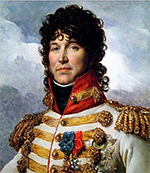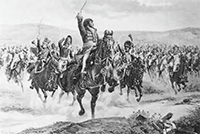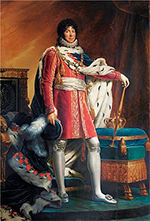French Marshal Joachim Murat
Joachim Murat was a famous commander for France during the Napoleonic Wars and also served as King of Naples for a time. 
He was born on March 26, 1767, at La Bastide-Fortunière. He had an older brother, and the boys' father intended Joachim to pursue a religious career. He got an education at Cahors and studied religious law at Toulouse. What he really wanted to do, however, was join the military, and so he did, enlisting in a cavalry regiment in 1787. He saw combat in a number of wars during the next several decades. He had the rank of captain in 1795, when Napoleon Bonaparte ordered him to help stop a rebellion against the Directory. Thus began a series of engagements in which Murat served with Bonaparte. Murat was Bonaparte's aide-de-camp in Italy in 1796 and commanded a cavalry force during the Battle of the Pyramids, in 1798. Murat was one of a handful of soldiers who returned with Bonaparte to France in 1799 and, newly promoted to the rank of general of division, oversaw the military force that aided Bonaparte's overthrow of the Directory and the installation of the Consulate. On Jan. 20, 1800, Murat married Caroline Bonaparte, Napoleon's sister; they had four children together. 
Murat went back to Italy with Bonaparte as head of the cavalry and saw action at the Battle of Marengo. He then served as governor of the Cisalpine Republic and as governor of Paris. In 1804, he became one of the 18 commanders named as Marshals by the newly crowned Emperor Bonaparte. Murat again led the cavalry when war broke out again, in 1805. He saw action at several significant battles, including Austerlitz, Jena, Eylau, and Friedland. 
Bonaparte named Murat the head of the French Army of Spain. His harsh treatment of the Spanish people inspired many to rebel against the French occupation. When Bonaparte named his brother Joseph to be the new King of Spain, Murat (who had wanted that kingdom) got the throne of Naples instead. As King of Naples, he referred to himself as Joachim-Napoléon and oversaw a series of reforms, including introducing the Napoleonic Code. Murat was back in the saddle again in 1812, as head of the cavalry of the Grand Armée of 650,000 that invaded Russia. He suffered through the throes of defeat and retreat (taking command when Bonaparte left to go quickly back to Paris to put down a coup attempt), even serving with Bonaparte during his defeat at Leipzig in 1813. Convinced that Bonaparte's days were numbered, Murat signed a treaty with Austria, in January 1814. That alliance counted for little at the Congress of Vienna, at which leaders of other European powers expressed an interest for returning King Ferdinand to the Neapolitan throne. When Bonaparte returned to France during the Hundred Days in 1815, Murat led his troops into battle against Austria. Austrian troops prevailed, at Tolentino, and Murat fled to France, where he found no favor with Bonaparte. A desperate Murat returned to Italy and tried to re-establish his rule. He was captured and court-martialed and, on Oct. 13, 1815, executed, at Pizzo, in Calabria.
|
|
Social Studies for Kids
copyright 2002–2025
David White




